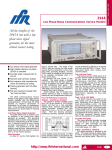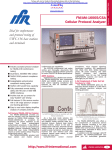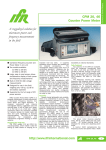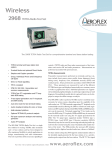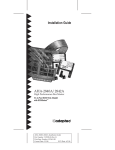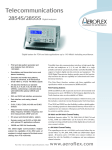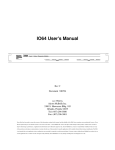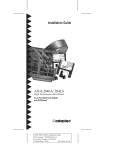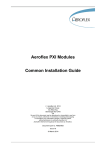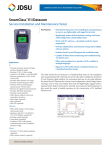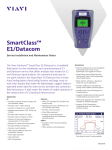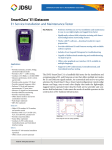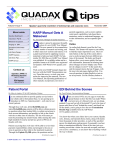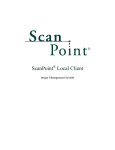Download 2840A/41
Transcript
Telecommunications Digital Communications Analyzer 2841 2 Mbit/s Transmission Analyzer 2840A Hand-held, high capability testing for 2 Mbit/s and data line systems and equipment Handheld, battery operated, data and PCM rate tester Framed and unframed operation at 2 Mbit/s including n x 64 kbit/s Data test interfaces: (2841) RS-232, X.21, V.35, RS-449 (V.36), codirectional, contradirectional G.821, G.826, M.2100 analysis Histograms for error distribution and alarms Print from up to 10 results stores Analog channel generation and measurement Measurements include propagation delay, output level attenuation, frequency deviation, frequency and level measurement, and CAS generated and received to enable a range of tests on framing, alarms and signaling. GENERAL The 2840A 2 Mbit/s Transmission Analyzer is a hand-held analyzer for installation and maintenance measurements on digital 2 Mbit/s lines and equipment. The 2841 Digital Communications Analyzer adds data interface testing to this 2 Mbit/s capability. The comprehensive measurement capability is contained in a compact, battery operated package, combined with a large graphics based LCD for ease of set up and results retrieval. Modes Both synchronous and asynchronous modes as possible with a wide range of standard and user programmable data rates, so that traditional data interface testing can be addressed together with modern digital data services at 64 kbit/s, n x 64 kbit/s and other rates. FRAMING SYSTEMS 2 Mbit/s framing systems with 30 and 31 channels, with and without CRC4, are 56 kbit/s and 64 kbit/s Channel Testing Individual channels can be tested at 64 or 56 kbit/s, assisting in testing and fault location within digital data networks and cross connect switches. n x 64 kbit/s Channel Testing n × 64 kbit/s channels can be tested where they are carried within 2 Mbit/s digital signals. Full flexibility is provided with both contiguous and non-contiguous channel selection. DATA INTERFACE TESTING (2841) All commonly used data interfaces are available to give a comprehensive data test capability together with 2 Mbit/s testing. Thus 2 Mbit/s and data circuits and equipment can be tested in a hand-held, fully integrated test instrument. Data test interfaces provided are RS-232, X.21, V.35, RS-449 (V.36), codirectional and contradirectional. DATA MULTIPLEX TESTING (2841) Independent transmitter and receiver enable connection to data and 2 Mbit/s interfaces simultaneously. This allows testing across a data multiplex to ensure integrity of data card to 2 Mbit/s path. COMPREHENSIVE ERROR AND ALARM MEASUREMENTS The 2840A and 2841 can detect simultaneously, Code, Framing, Pattern and CRC Errors. Further measurements are then made on a selected error type, including G.821, G.826, M.2100 and error distribution. Error Distribution and Alarm Histograms The error results and alarms are displayed in the form of a histogram with accumulation up to 7 days, and resolution up to 1 second. This provides a comprehensive record of long term measurements to assist in fault localisation. A permanent record of these results can be obtained by printing a text equivalent or a facsimile of the histograms subsequent to the test. Full Results Printing - Print from RAM The instrument can be programmed to Autoprint selected parameters from the full set, on event or on timed intervals. These include errors, performance parameters, and alarms. Alternatively up to 4000 print events per results store can be stored in memory (Print from RAM) for subsequent printing. This also removes the necessity of real time printing where subsequent analysis via a PC may prove this to be unnecessary. G.821, G.826 and M.2100 Measurements The usual ITU-T recommendation of G.821 for 64 kbit/s error performance measurement is applied. In addition the newer Recommendation G.826 extends measurements to 2 Mbit/s, while M.2100 http://www.ifrinternational.com 2841/2840A 1 2841/2840A MULTIPLE TEST STORAGE Up to 8 full sets of results can be stored for later on screen analysis or printing. Again this can avoid real time printing. RESIDUAL BIT ERROR RATE Assessment of background error performance is useful in systems subject to degraded error performance, such as radio or satellite systems. RBER is long term mean error rate ignoring Severely Errored Seconds. HIGH TOLERANCE TO BURST ERRORS 2840A and 2841 are particularly suited to measurements on systems subject to high error rates and burst errors, with the ability to ride through rapid fades as experienced on digital radio systems. PROGRAMMABLE ERROR GATING In addition to long term mean error ratio, a current error ratio is available with fixed gating periods of 1, 2, 5 or 10 seconds. Flexibility of application is thus assured, for example fade margin adjustment on digital radios. IN-SERVICE AND OUT-OF-SERVICE MEASUREMENTS The instrument is equally suited to installation and maintenance measurements. Interfaces are provided to enable the receiver to be connected to a number of network points at varying impedances and sensitivities. Automatic line equalization (automatic line build out, ALBO) is also provided to enable connection to signals attenuated by long sections of line. IN-SERVICE CHANNEL ACCESS Access is provided to receive timeslots for both analog and digital signals. Voice Channels Voice channels within a 2048 kbit/s signal can be monitored in-service and routed to an internal loudspeaker or a headphone socket for a first level check of analog level and quality. Data Channels 64 kbit/s data channels can be routed to a V.11 interface for external measurement, for example connection of common channel signaling to a protocol analyzer. Drop and Insert Selected 64 or n x 64 kbit/s channels within an in-service 2048 kbit/s signal can be tested with minimum disruption of service to other in-traffic channels. NETWORK EQUIPMENT TESTING Comprehensive facilities enable the range of applications to be extended beyond digital link error performance testing to checking the functionality of various types of network equipment such as multiplexes and cross connect switches. Multiplex Equipment 2840A and 2841 are able to simulate and detect alarm conditions associated with the various 2048 kbit/s frame structures, including full frame alignment strategy testing to G.706. In addition the input level margin of the multiplex can be checked using the output 2 2841/2840A level attenuation capability whilst frequency margin can be checked using the output frequency offset capability. Cross Connect Switches Cross Connect switches can be checked for switch path integrity using the 64 kbit/s channel test capability (or n × 64 kbit/s for new generation switches). ANALOG CHANNEL MEASUREMENTS Analog measurements are made on selected 2 Mbit/s channels including frequency response and linearity. The transmitter can generate sine waves across the full audio band with frequency and level resolution of 1 Hz and 0.1 dB respectively. Measurements are made of peak code, RMS level and frequency. PROPAGATION DELAY MEASUREMENT Delay measurements can be made on 2048 kbit/s digital circuits to a high level of accuracy. This is particularly important on satellite links where high values of delay are experienced and need to be measured, or for characterising networks to assist in finding unwanted loopbacks. Where data circuits are extended from 2048 kbit/s bearers out to subscribers, the overall network to subscriber loop delay can be measured at 64 or n x 64 kbit/s from within the 2048 kbit/s signal. CHANNEL ASSOCIATED SIGNALING The 4 bit word associated with a selected channel can be controlled on the transmitter. On the receiver all 30 channels can be monitored simultaneously. In addition for a selected channel the last 16 signaling word changes can be stored for later analysis. DIGITAL SIGNAL LEVEL AND FREQUENCY MEASUREMENT The frequency and amplitude of the incoming digital signal are displayed to enable early warning of degradation of the signal, or to check the loss of in-station cabling to ensure it conforms to limits. BIT SLIP DETECTION Single, uncontrolled bit slips can be detected within framed or unframed test patterns. This allows inter and intra network clocking problems to be isolated. OCTET SLIP DETECTION Octet slips can be detected at the 64 kbit/s channel level of a 2048 kbit/s signal, which allows the effects of frame slips introduced by network buffers to be assessed. EASE OF USE The instrument is set up quickly and easily using graphics based menu selection on a large LCD, with key pad and soft keys. Commonly used instrument configurations can be stored in memory further ensuring ease of use. RS-232 REMOTE OPERATION Remote unattended operation can be accomplished via an RS-232 port, which can also be used for local printing. Keyboard functions can be duplicated via RS-232 commands enabling complete remote configuration and reporting of results. POWER OPTIONS Internal batteries give five hours operation when both transmitter and receiver are being used. Battery life is extended in monitoring applications where the transmitter can be switched off. Fast charge circuits coupled with an AC power adaptor enable recharge in only three hours. For extended operation the AC power adaptor can be used with the batteries as standby in the event of power failure. Specification 2 Mbit/s Transmit Interface FRAMING AND BIT RATES Signals can be transmitted unframed or with the frame structure indicated. 2048 kbit/s - G.704 2048 kbit/s - G.704 no multiframe 2048 kbit/s - G.704 with CRC 2048 kbit/s - G.704 with CRC, no multiframe 2048 kbit/s - 32 frame multiframe (Option 02, French) CLOCK SOURCE Internal, external or derived from the received signal Internal Accuracy ±1 ppm from 0° C to 55° C ±1 ppm / year Frequency Offset Small Steps of ±5 and ±50 ppm to ±150 ppm Large Steps of ±2 and ±10 kbit/s to ±30 kbit/s External TTL Sine wave G.703 Figure 21 LINE CODES AMI (50% duty cycle) HDB3 TEST PATTERNS Insertion Single Channel Selected 56 kbit/s or 64 kbit/s channel of framed signal Channel Broadcast All 56 kbit/s or 64 kbit/s channels of framed signal n × 64 kbit/s Channel Selected n × 56 kbit/s or n × 64 kbit/s channels of framed signal Channel distribution can be contiguous or noncontiguous Unframed Unframed signal PRBS 26-1 29-1 211-1 215-1 220-1 223-1 Sense True or Inverted Mode (framed only) 8 bit PRBS data fills all 8 bits in an octet, ie 64 kbit/s per channel 7 + 1 bit First 7 bits are PRBS and last bit is a 1, ie 56 kbit/s per channel 32 bit word User programmable sequence of 32 bits (16 bit word for Option 02, French) http://www.ifrinternational.com Variable Sine Wave (option 04 on 2840A) Frequency Range 1 to 3999 Hz Resolution 1 Hz Level +3 to -55 dBm0 Resolution 0.1 dB maximum. Coding A-Law Signaling multiframe alignment strategy. Set x in 2 consecutive multiframe words in error, single shot or continuously FILL PATTERNS For 64 or n × 64 kbit/s operation the following patterns are used to fill all other channels ACCESS TO STRUCTURE BITS Change unassigned, distant, distant multiframe and alarm bits. Time Slot 16 (Signaling). Set to AIS (All 1s). Set to All 0s. 2 Mbit/s Receive Interface PRBS 215-1 8 bit word User programmable sequence of 8 bits DROP & INSERT For framed operation the received signal is looped to the transmitter Note that for CRC frame structures the CRC is recalculated before transmission 56 kbit/s or 64 kbit/s A selected 56 kbit/s or 64 kbit/s channel is replaced by a test pattern. n × 56 kbit/s or n × 64 kbit/s A selected n × 56 kbit/s or n × 64 kbit/s channel is replaced by a test pattern. The channel selection can be contiguous or non-contiguous. REGENERATOR LINE CURRENT LOOPTHROUGH Line current on balanced lines can be looped through from receiver to transmitter of the instrument. ERROR INJECTION Target Test Pattern Only Framing Only CRC Only All FRAMING AND BIT RATES Signals can be received unframed or with the frame structure indicated. As Transmitter. Frequency Tolerance 2048 kbit/s ±50 ppm LINE CODES As Transmitter. Indication of HDB3 signal present AUTOCONFIGURE The receiver can be set to autoconfigure to: 2 Mbit/s framed test pattern or unframed test pattern. 64 kbit/s channel test pattern (channel search or known channel). n × 64 kbit/s channel test pattern (known channel). INPUT MODES AND SENSITIVITY Modes Terminated Bridging Terminates the line. Taps onto a terminated line or unprotected monitor point. Connects to a protected monitor point. Monitoring Error Type Binary Bits are inverted before coding. Code Code errors are injected by changing ±1 to 0 and 0 to ±1 where the polarity of the inserted mark is the same as the polarity of the last mark transmitted. Injection Mode Singly By keypress Fixed rate Rate M x 10-N, where M is 1 to 9 and N is 2 to 7 MAIN OUTPUTS BALANCED Impedance Normal ALBO 120 Ω 3 V ±0.3 V 0 V ±0.3 V Unbalanced Impedance Peak Voltage Space Voltage 75 Ω 2.37 V ± 0.237 V 0V ± 0.237 V Impedance ALBO Output Level Attenuation Attenuation 6 and 10 dB Accuracy ±0.5 dB SIGNALING BIT CONTROL For framing systems with Channel Associated Signaling capability the signaling bits can be changed. Selected Channel Set 4 bit word. All Other Channels Set 4 bit word. C-BIT FRAMING (Option 02, French) Generation of C-Bit Frame for French TRANSMIC-2G System. Control of C-Bit Frame message bits. FRAMING TESTS The following tests are available, depending on the framing system selected: Frame alignment strategy Set x in 4 consecutive frame words in error, single shot or continuously Set x in 3 consecutive frame bits in error, single shot or continuously Set x in 4 consecutive CRC multiframe words in error, single shot or continuously Set x in 1000 CRC blocks in error continuously (default value is 915). Bridging >1000 Ω 3V 3V +2 to -6 dB +2 to -6 dB 3V +2 to -30 dB Monitor 120 Ω (3000 Ω) 3V -15 to -36 dB UNBALANCED Normal Balanced Impedance Peak Voltage Space Voltage Terminated 120 Ω Terminated 75 Ω Bridging >1000 Ω 2.37 V 2.37 V +2 to -6 dB +2 to -6 dB 2.37 V +2 to -30 dB Monitor 75 Ω (2400 Ω) 2.37 V -15 to -36 dB TEST PATTERNS: Source Selected single, contiguous, non-contiguous channels of framed signal. Unframed signal. PRBS 26-1 29-1 211-1 215-1 220-1 223-1 Sense True or Inverted Mode (framed only) 8 bit PRBS data fills all 8 bits in an octet, ie 64 kbit/s per channel 7 + 1 bit First 7 bits are PRBS and last bit is a 1, ie 56 kbit/s per channel Repetitive Word Any word which repeats over a 32 bit sequence. (16 bit sequence for Option 02, French) PATTERN SYNCHRONIZATION Loss Criterion PRBS error rate greater than 1 in 5 for each of 10 consecutive desciseconds. CHANNEL EXTRACT For framed single channel operation a selected 64 kbit/s channel is extracted from the received signal: Channel selection by increment and decrement keys Voice frequency signals are routed to the internal loudspeaker, audio output socket, or headphone socket. 64 kbit/s data signals are output via a V.11 socket. AUDIO CHANNEL MEASUREMENT (option 04 on 2840A) Frequency, Level, Peak code Frequency Range 1 to 3999 Hz Resolution 1 Hz RMS Level Range +6 to -60 dBm0 Resolution 0.1 dB maximum Peak code Positive and negative values are displayed. Decoding A-Law Telecommunications 2841/2840A VOICE FREQUENCY OUTPUT (opt 04 on 2840A) Range 0.3 to 3400 Hz Decoding A-Law Impedance 600 Ω balanced STATUS INDICATORS LEDs indicate frame structure alarm conditions Display modes CURRENT ALARMS Red LEDs illuminate to indicate alarm presence and extinguish when the condition clears. LEDs respond to alarm conditions with a resolution of one second. HISTORY When ALARM HISTORY is pressed the CURRENT ALARM LEDs indicate alarms which have illuminated since the last time the history reset button was pressed. RESET resets the ALARM HISTORY. SIGNAL GOOD Green LED illuminates to show absence of combination of LINE, AIS, FRAME, MF, CRC and PATTERN alarms. LINE Red LED ON indicates signal loss. AIS Red LED ON indicates signal is all 1’s. All 1’s is defined as signal with less than three zeros in two frame periods. FRAME Red LED ON indicates a loss of frame alignment. CRC MF Red LED ON indicates loss of CRC multiframe alignment. CAS MF Red LED ON indicates loss of signaling multiframe alignment. DISTANT Red LED ON indicates DISTANT alarm. DMR Red LED ON indicates Distant Multiframe Alarm. PATTERN Red LED ON indicates loss of pattern synchronisation. ERROR RATE Red LED ON indicates that the error rate of the major error type is greater than a threshold set by the user. Threshold is 1 x 10-N where N is 2 to 9. ERRORS Red LED ON indicates major errors detected. Additional Display Indicators (Auxiliary Alarms Page) HDB3 SIGNAL Present or Not Present TS16 AIS Present or Not Present UNASSIGNED FRAMING BITS The state of the unassigned bits is displayed. Data Test Interfaces (2841) X.21, RS-449 (V.36), V.35, RS-232, Co/Contradirectional and TTL X.21, RS-449 (V.36), V.35, RS-232 and Co/Contradirectional X.21 (V.11), RS-449 (V.11), V.35, RS-232 and Co/Contradirectional are presented to a common connector. DTE/DCE interfaces are provided by adaptor cables which provide the appropriate connector and electrical interface. The DTE/DCE switching is internal. Universal Connector 68 way type PCR female. http://www.ifrinternational.com 2841/2840A 3 2841/2840A Adaptor Cable Connectors X.21 15 way D-Type, ISO 4903 female. RS-449 (V.36) 37 way D-Type, ISO 4902 female. V.35 34 way MRAC, ISO 2593 female. RS-232 25 way D-Type, ISO 2110 female. Co/Contradirectional 15 way D-Type, ISO 4903 female. Codirectional CF x 2 female. IMPLEMENTATION X.21, RS-449 (V.36), V.35, RS-232 DTE. DCE. Cable recognition Automatic recognition of the cable type plugged in. TTL Code Connector NRZ Miscellaneous 25 way D-Type CONTROL LINES X.21 DTE I (Indication) C (Control) RS-449 (V.36) DTE CS (Clear to send) RS (Request to send) DTR (Data terminal ready) DSR (Data set ready) DCE C (Control) I (Indication) DCE RS (Request to send) CS (Clear to send) DSR (Data set ready) DTR (Data terminal ready) DCD (Data Carrier Detect) DCD (Data Carrier Detect) V.35 DTE CS (Clear to send) RS (Request to send) DTR (Data terminal ready) DSR (Data set ready) RTS (Request to send) DTR (Data terminal ready) Displayed as 1, 0 Settable to 1, 0 Settable to 1, 0 Displayed as 1, 0. Settable to 1, 0. Displayed as 1, 0. DCE RS (Request to send) CS (Clear to send) DSR (Data set ready) DTR (Data terminal ready) DCD (Data Carrier Detect) DCD (Data Carrier Detect) RS-232 DTE CTS (Clear to send) DSR (Data set ready) RLSD (Receive line signal detect) TM (Test mode) Displayed as 1, 0. Settable to 1, 0 Displayed as 1, 0. Settable to 1, 0 Settable to 1, 0. Displayed as 1, 0. Settable to 1, 0. Displayed as 1, 0. DCE RTS (Request to send) DTR (Data terminal ready) LL (Local loop) RL (Remote loop) CTS (Clear to send) DSR (Data set ready) RLSD (Receive line signal detect) TM (Test mode) LL (Local loop) RL (Remote loop) Displayed as 1, 0. Displayed as 1, 0. Displayed as 1, 0. Displayed as 1, 0. Settable to 1, 0 Settable to 1, 0 Settable to 1, 0. Settable to 1, 0. Set to 1 for V.54 selected Set to 0 for V.54 deselected Set to 1 for V.54 selected Set to 0 for V.54 deselected MODE Synchronous X.21, RS-449 (V.36), V.35, RS-232, TTL Asynchronous RS-449 (V.36), RS-232 loop 3 loop 3 loop 2 loop 2 Electrical X.21 V.11 (balanced) RS-449 (V.36) V.11 (balanced) V.35 V.35 (data and timing) V.28 (control lines) RS-232 V.28 Input Impedance X.21, RS-449 (V.36) V.11 Terminated 120 Ω V.11 Unterminated >3000 Ω V.35 100 Ω Data Rate X.21, RS-449 (V.11) (Sync) 50 bit/s to 2.5 Mbit/s V.35 (Sync) 50 bit/s to 2.5 Mbit/s. RS-232 (Sync) 50 bits/ to 80 kbit/s RS-232, RS-449 (Async) 50 bit/s to 38.4 kbit/s TTL 50 bit/s to 2.5 Mbit/s Timing Synchronous Transmit - DTE From DCE DCE input timing. Internal 1 bit/s steps. Receiver Receiver clock (assumes receiver is data interface, not 2048 kbit/s, and same rate as transmitter) External TTL input. Transmit - DCE Internal 1 bit/s steps. Receiver Receiver clock External TTL input. Receive - DTE From DCE DCE input timing External TTL input. Signal Extracted from receive signal Receive - DCE From Transmitter Transmit clock (assumes transmitter is data interface, not 2048 kbit/s, and same rate as receiver) External TTL input. Signal Extracted from receive signal. DTE From DTE Transmit - TTL Internal 1 bit/s steps. Receiver Receiver clock (assumes receiver is TTL interface, not 2048 kbit/s, and same rate as transmitter). External TTL input. Receive - TTL External TTL input. Signal Extracted from receive signal. From Transmitter Transmit clock. All input and output timing signals can be inverted in polarity. Asynchronous Transmit Internal 50, 75, 100, 110, 134.5, 200, 600, 1200, 1800, 2000, 2400, 3600, 4800, 7200, 9600, 14400, 19200, 38400 bit/s. Receive Receive signal. Async coding Data bits 7, 8. Stop bits 1, 2. Parity Odd, even, mark, space, none. Async character rate Transmitter Selectable: low medium, high, (10, 50 and 100% maximum character rate). Receiver Up to 1000 character/sec. TEST PATTERNS Sync and async PRBS 26-1 29-1 211-1 215-1 220-1 223-1 Sense True or inverted Sync 32 bit word User programmable sequence of 32 bits Async Fox message 3 messages to ITU-T Recommendation R.52. Fox 1 International alphabet 2. Fox 2 International alphabet 5, 96 character set Fox 3 International alphabet 5, 64 character set. User message 1 to 64 characters. ERROR INJECTION Singly By keypress Fixed rate Rate 9 × 10-2 to 1 × 10-7 (sync only) ALARMS Line Errors Pattern No transmit clock PROPAGATION DELAY (sync only) Measured using a PRBS test pattern Range Up to 2 seconds Resolution 1 bit period Update rate Typically 2 seconds. Can be longer at low data rates. TIMING MEASUREMENT (DTE only) Time intervals between changes of control lines X.21 C and I RS-449 (V.36) RS and CS V.35 RTS and CTS Range 0 to 10s Resolution 1 ms BIT RATE MEASUREMENT (Transmitter and Receiver) Measurement of transmitter bit rate confirms DCE clock rate when DTE, or external clock rate. Sync The bit rate is measured every second displayed to nearest 1 Hz. Async The character rate is measured every second displayed to nearest 1 Hz. Accuracy ±1 ppm. Sense 4 2841/2840A http://www.ifrinternational.com Line signal coding and level Bit Rate Format Transmit Timing DTE DCE Receive Timing DTE DCE Pinouts 1, 9 3, 11 5, 13 7, 15 4, 12 6, 14 8 Residual Bit Error ratio (Background Error Rate) Long Term Mean Error Ratio excluding Severely Errored Seconds. Codirectional To ITU-T Rec. G.703 64 kbit/s Unstructured Contradirectional To ITU-T Rec. G.703 64 kbit/s Unstructured Receiver (from DCE) Internal External 2048 kbit/s Internal (to DTE) External 2048 kbit/s From DCE Internal Receiver External 2048 kbit/s Internal (to DTE) External 2048 kbit/s Extracted from receiver signal (from DCE) Extracted from receiver signal (from DTE) Extracted from receiver signal Internal (to DTE) External 2048 kbit/s Transmit Data Receive Data Transmit Data Receive Data Transmit Clock In (from DCE) Receive Clock In (from DCE) Transmit Clock Out (to DTE) Receive Clock Out (to DTE) Earth Earth X.21 -DTE/DCE Pins 4,11 6, 13 5, 12 7, 14 Pins 2, 9 3, 10 8 From DTE (To DCE) Transmit Control Ground Circuit T C Pins 4,22 17,35 19 7,25 12,30 From DTE (To DCE) SD Send Data TT Tx Timing Signal Ground RS (Request To Send) DTR (Data Terminal Ready) Pins P,S U,W B C H From DTE (To DCE) Transmit Data Transmit Timing Signal Ground Request to send DTR (Data Terminal Ready) 105 108/2 Pins 2 24 4 20 18 21 7,1 From DTE (To DCE) Transmit data Transmit timing Request to send Data terminal ready Local loop Remote loop Ground RS-232 - DTE/DCE Circuit Pins 103 3 113 17 105 15 108 5 141 6 140 8 25 Pins 1 2 3 4 5 6 7, 19 8, 20 9 TTL (Miscellaneous connector) Pins Power Feed Loopthrough A 10, 22 64 kHz clock out (V.11) Power Feed Loopthrough B 11, 23 64 kHz data out (V.11) Receive 2 Mbit/s or Data clock out 12, 13 Audio out (600 Ω) Transmit 2 Mbit/s or Data clock out 14 Receive 2 Mbit/s or Data clock in Transmit 2 Mbit/s or Data clock out 15 Transmit 2 Mbit/s or Data data in Transmit external clock in 16, 17, 18 Earth 8 kHz frame clock out (V.11) 21, 24, 25 Earth Octet market out (V.11) N/C RS-449 (V.36) - DTE/DCE Circuit Pins 103 6,24 113 8,26 5,23 105 9,27 108/2 11,29 13, 31 Circuit 103 113 V.35 - DTE/DCE Pins R,T V,X Y,AA D E F Measurements ERROR TYPES Line Code (Bipolar Violations) Frame Bit Frame Word Pattern CRC (Pattern errors only for data test interfaces) Main parameters: Made if the framing system and Test Mode allow. Number of Errors. Long Term Mean Error Ratio (LTMER). Total Test Time. Number of Loss of Signal (LOS) seconds. Number of AIS seconds. Number of No Frame Alignment seconds. Number of No Pattern Sync seconds. Number of No CRC Sync seconds. To DTE (From DCE) Receive Timing Indication Byte Timing Circuit R S I B To DTE (From DCE) RD Receive Data RT Rx Timing ST Send Timing CS (CTS) DSR (Data Set Ready) DCD (Data Carrier Detect) Circuit 104 115 114 106 107 109 To DTE (From DCE) Receive data Receive timing Transmit timing Clear to send DSR (Data Set Ready) DCD (Data Carrier Detect) Circuit 104 115 114 106 107 109 To DTE (From DCE) Receive data Receive timing Transmit timing Clear to send Data set to ready Receive line signal Test mode Circuit 104 115 114 106 107 109 142 OCTET SLIPS Octet Slips are detected for single channel pattern measurements: Number of positive and negative slips. Time of last slip. Time between last two slips. BIT SLIPS Single bit slips are detected within a 64 or n × 64 kbit/s test pattern within a 2 Mbit/s signal, an unframed 2 Mbit/s test pattern, or an unframed test pattern via one of the data test interfaces. Positive and negative bit slips are counted. (Bit Slips and Octet Slips are mutually exclusive). ADDITIONAL PARAMETERS Current Error Ratio Gating 1, 2, 5 or 10 seconds. G.821 ERROR PERFORMANCE MEASUREMENTS 64 kbit/s channel availability measurements are made to ITU-T Recommendation G.821, while for higher rates a channel performance to G.821 Annex D is applied. Parameters % Available Time. Number of Errored Seconds. % Error Free Seconds. Number of Severely Errored Seconds (SES). % Non SES. Number of Degraded Minutes (DM). % Non DM. Number of Breaks. The inverse % parameters are also available. User programmable thresholds for %ES (%Errored Seconds), %SES (%Severely Errored Seconds), %DM (%Degraded Minutes) and %US (%Unavailable Seconds). Exceeding the threshold during a test causes message. Threshold activation settable for each parameter YES/NO. Parameter %ES %SES %DM %US Limit XX.XXXX XX.XXXX XX.XXXX XX.XXXX Telecommunications 2841/2840A Message %ES > limit %SES > limit %DM > limit %US > limit X=1 to 9 M.2100 Implementation of Interpretation for the Receive and Send Direction columns in Table B2/M.2100 for 2 Mbit/s signal (non CRC4) and 2 Mbit/s (CRC4). User programmable thresholds S1 and S2 for ES (Errored Seconds), SES (Severely Errored Seconds) and US (Unavailable Seconds). Exceeding the threshold during a test causes message. Threshold activation settable for each parameter YES/NO. Parameter S1 Limit ES XXXX S2 Limit XXXX SES XXXX XXXX US XXXX XXXX Message ES >S1 limit or ES > S2 limit SES > S1 limit or SES > S2 limit US > S1 limit or US > S2 limit X=1 to 9 G.826 Parameters Number of Errored Blocks (EB). Number of Errored Seconds (ES). Number of Severely Errored Seconds (SES). Number of Background Block Errors (BBE). Errored Second Ratio (ESR). Severely Errored Seconds Ratio (SESR). Background Block Error Ratio (BBER). Unavailable Seconds (US). % Unavailable Seconds (%US). % Available Seconds (%AS). Number of Breaks. User programmable thresholds for ESR (Errored Seconds Ratio), SESR (Severely Errored Second Ratio), BBER (Background Block Error Ratio) and %US (% Unavailable Seconds). Exceeding the threshold during a test causes message. Threshold activation settable for each parameter YES/NO. Parameter ESR SESR BBER %US Limit X.XE-Y X.XE-Y X.XE-Y X.XXXX Message ESR > limit SESR > limit BBER > limit %US > limit X=1 to 9, Y=2 to 8 PROPAGATION DELAY Measured using a PRBS test pattern. Mode 2048 kbit/s unframed. 64 kbit/s channel within 2048 kbit/s signal. n × 64 kbit/s channel within 2048 kbit/s signal. Range Up to 2 seconds http://www.ifrinternational.com 2841/2840A 5 2841/2840A C-BIT FRAMING Resolution 1 µs or 1 bit whichever is the greater (Option 02, French) Monitoring of C-Bit Frame for French TRANSMIC-2G System. Display of C-Bit Frame message bits. Update rate Typically 2 seconds. STORED RESULTS Storage Capacity Up to 4,000 events per results store including errors and alarms stored with a time and date stamp to a resolution of 1 second. Multiple Tests 8 full sets of results stored. Results Retrieval Print to external printer. Selected results histograms. Mark portion of histogram and print selection of errors, alarms and periodic results between marks. Error and Alarm Distribution Histograms Any one of the following parameters can be selected as the histogram display: Parameters Major Errors Errored Seconds Severely Errored Seconds Degraded Minutes Unavailability Breaks Loss of Signal AIS Loss of Frame Alignment Loss of Pattern Synchronisation Range +3 to -10 dB ±1 dB -10 to -20 dB ±2 dB -20 to -36 dB ±3 dB SET UP Copy facility from Transmitter to Receiver and Receiver to Transmitter. Histogram page width 7 or more days with a resolution of 1 day. 30 hours with a resolution of 1 hour. 30 minutes with a resolution of 1 minute. 30 seconds with a resolution of 1 second. The display is selectable from anywhere within the N days. Display The stored results are displayed as a histogram. A cursor is moved to point at any day, hour, minute or second. The number of events for the parameter selected for that interval are displayed together with the date and time. Histogram Baseline Alarms Alarms history is shown by histogram baselines. Totals for each alarm can be determined by displaying as the main histogram with cursor scrolling and reading of alarm totals for each interval. signal Frame Alignment Pattern Synchronization Power (not available on the main histogram) TEST TIMING Start time YYYY, MM, DD, HH, MM (year, month, day, hour, minute). By keypress Stop time YYYY, MM, DD, HH, MM (year, month, day, hour, minute). By keypress. Duration DD, HH, MM (days, hours, minutes) Indefinite. SIGNALING ANALYSIS Channel associated signaling analysis for selected channel. Display: Decimal and binary equivalent of current and previous 16 signaling codes. Signaling code for all 30 channels simultaneously, with programmable IDLE and BUSY display. 2841/2840A DIGITAL SIGNAL VOLTAGE MEASUREMENT The amplitude of the incoming digital signal is measured and displayed in Volts base-to-peak and dB relative to nominal. General Characteristics Accumulation time Typically 7 days or better 6 Accuracy ±1 ppm. OPERATOR INTERFACE The instrument is controlled via a keyboard containing a data entry keypad. The 24 line 42 character (plus graphics capability) LCD and keyboard are fully interactive providing menu and soft-key operation. Resolution 1 second, 1 Minute, 1 Hour, 1 Day Alarms Loss of AIS Loss of Loss of Loss of BIT RATE MEASUREMENT The received bit rate is measured every second displayed to nearest 1 Hz. DISPLAYS Transmit parameters Receive parameters Measurement results RS-232C port parameters Printer type selection Measurement definition Autoprint definition Setup conditions (Stored Parameters) Current status Zoom Selected results can be displayed in zoom mode with large character size. AUDIBLE ALARM Mode When on alarm sounds on detection of: A signal alarm. An errored second. LOUDSPEAKER Selected 64 kbit/s channels can be routed to the loudspeaker. There is a volume control. SETUP CONDITIONS (STORAGE FACILITY) A variety of information can be stored in non-volatile memory (battery backed-up). Setup Conditions 6 sets of transmitter/receiver/test definition parameters can be selected for storage. Each set can be recalled whenever required, and can be identified with a 12 character label. In addition 13 non-alterable standard setups are available: Unframed Transmitter and Receiver 30 Channel n × 64 kbit/s 31 Channel n × 64 kbit/s 30 Channel n × 64 kbit/s with CRC4. 31 Channel n × 64 kbit/s with CRC4. 30 Channel n × 64 kbit/s, Drop and Insert 31 Channel n × 64 kbit/s, Drop and Insert 30 Channel n × 64 kbit/s with CRC4, Drop and Insert 31 Channel n × 64 kbit/s with CRC4, Drop and Insert 30 Channel Monitor Live Traffic. 31 Channel Monitor Live Traffic. 30 Channel with CRC4 Monitor Live Traffic. 31 Channel with CRC4 Monitor Live Traffic. KEYBOARD LOCKOUT The keyboard can be disabled whilst a test is running. PRINTER OPERATION The RS-232 port is used for printer operations and remote control Printers 40 column minimum, RS-232 interface Page Printing Page printouts are initiated by the PRINT key and cause the whole of the current page to be printed. Graphics display pages can be printed in a text equivalent or a facsimile to a suitable printer. Autoprinting The printer can be set to print automatically on the occurrence of any of the following (where applicable), each event printed with its date and time and two digit identity number. A twelve character label is also printed where appropriate: Test start and stop. Loss and restoration of signal. Loss and restoration of alignment. Loss and restoration of pattern sync. Detection of errors (ES). Detection of alarms. Detection of octet slips. Detection of short term (current) error ratio, for the selected major error type, crossing a user set threshold. Detection of change of signaling code. Cumulative printout at user selectable intervals, with a resolution of 15 minutes. All stored results may be included in the interval print. User selectable. Loss and restoration of power. REMOTE CONTROL The RS-232 port is used for Remote configuration and collection of results. RS-232 PORT The RS-232 port is used for printer operations and remote control. Type Asynchronous DTE Full Duplex Bit Rates 300, 600, 1200, 2400, 4800 and 9600 bit/s. Code ASCII Code bits. Parity/Stop bits 7/Odd/1, 7 /Even/1, 7/Odd/2, 7/Even/2, 8/None/1, 8/None/2 Terminator None, CR, LF, CR \ LF. Handshake Hardware DTR, RTS, CTS and DSR. Software XON and XOFF. Lines used Tx DATA RTS DTR Rx DATA CTS DSR Signal Ground Pin Pin Pin Pin Pin Pin Pin 3 7 4 2 8 6 5 Connector 9 way female D-type Electrical To RS-232C / V.28 DISPLAY LANGUAGES English, French LIMIT RANGE OF OPERATION REAL TIME CLOCK Displays date and time. Temperature 0 to 55°C (Display specified to 50°C) Resolution One second Safety Complies with IEC 1010-1, BS EN61010-1 for class 3 hand-held equipment and is for use in a pollution degree 2 environment. The instrument is designed to operate from an installation category 1 supply. Accuracy ±1 minute per week. http://www.ifrinternational.com CONDITIONS OF STORAGE AND TRANSPORT Versions and Accessories Temperature -40 to +70°C When ordering please quote full ordering number information. Humidity Up to 90% relative humidity (non condensing) Ordering Numbers 2841 2840A Altitude Up to 2500 m (pressurized freight at 27 kPa differential) ELECTROMAGNETIC COMPATIBILITY Conforms to the protection requirements of Council Directive 89/336/EEC. Complies with the limits specified in the following standards. BS EN55011 Class B CISPR 11. BS EN55082-1. IEC 801-2, 3, 4. POWER REQUIREMENTS The instrument is powered by internal batteries which give a nominal 5 hours operation. This is extended in receive only mode. UNIVERSAL AC POWER ADAPTOR The AC power adapter is capable of powering the instrument and at the same time recharging the batteries in 3 hours. AC Voltage 90 to 264 V. 46662/561 54311/190 54311/191 54311/209 Consumption 20 VA maximum. DIMENSIONS AND WEIGHT Height 77 mm 57mm 46882/290 46882/227 46662/560 54311/192 54311/193 54311/194 Frequency 45 to 440 Hz 2841 2840A Option 01 Option 02 Option 04 Width 206 mm 206mm Depth 170 mm 170mm Weight 1.5 kg 1.3kg 54311/211 54311/212 54311/213 54311/214 54311/215 46880/075 54311/190 54311/191 54311/192 54311/193 54311/194 54311/209 54311/211 54311/212 54311/213 54311/214 54311/215 54311/121 54311/122 54311/147 54311/148 54311/130 46662/562 54717/039 54311/217 46662/620 46883/805 54311/210 46662/387 46662/388 46662/564 Versions Digital Communications Analyzer. 2Mbit/s Transmission Analyzer. Options 1.6/5.6 connectors. French key panel, C-Bit frame. Analog generation and measurement (2840A only - standard on 2841). Supplied Accessories Operating Manual 2841. Operating Manual 2840A. Universal AC Power Adapter (90 - 264V). Carrying Pouch. One adaptor lead from the list below selected at time of order (2841). Adaptor Leads (2841) One specified lead supplied at no charge. Additional leads can be ordered from the list below. X.21 (V.11) Adaptor Lead, 0.2m, female. RS-449 (V.11) Adaptor Lead, 0.2m, female. V.35 Adaptor Lead, 0.2m, female RS-232 Adaptor Lead, 0.2m, female. Co/Contradirectional Adaptor Lead - 15 way D-Type, 0.2m, female Codirectional Adaptor Lead - CF connectors, 0.2m, male. X.21 (V.11) Adaptor Lead, 2m, male. RS-449 (V.11) Adaptor Lead, 2m, male. V.35 Adaptor Lead, 2m, male. RS-232 Adaptor Lead, 2m, male. Co/Contradirectional Adaptor Lead - 15 way D-Type, 2m, male. Optional Accessories Service Manual. X.21 (V.11) Adaptor Lead, 0.2m, female (2841). RS-449 (V.36) Adaptor Lead, 0.2m, female (2841). V.35 Adaptor Lead, 0.2m, female (2841). RS-232 Adaptor Lead, 0.2m, female (2841). Co/Contradirectional Adaptor Lead - 15 way D-Type, 0.2m, female (2841). Codirectional Adaptor Lead - CF connectors, 0.2m, female (2841). X.21 (V.11) Adaptor Lead, 2m, male (2841). RS-449 (V.11) Adaptor Lead, 2m, male (2841). V.35 Adaptor Lead, 2m, male (2841). RS-232 Adaptor Lead, 2m, male (2841). Co/Contradirectional Adaptor Lead - 15 way D-Type, 2m, male (2841). RS-232 Lead - male to male - 25 Way DType - 1.5m (2841). X.21 Lead - male to male - 15 way D-Type - 1.5m (2841). RS-449 Lead - male to male - 37 way DType - 1.5 m (2841). V.35 Lead - male to male - 34 Way MRAC 1.5 m (2841). Co/Contradirectional Test Lead - 15 way DType to free end (2841). Hard Carrying Case. Scriptos printer. RS-232 special lead Scriptos to 2841. Scriptos paper 10 packs. Signal lead balanced (CF-CF). Signal lead unbalanced (BNC-BNC). Null Modem (female to male). BNC to 1.6/5.6 adaptor. RS-232 adaptor - 9 way male to 25 way female D-Type. http://www.ifrinternational.com 2841/2840A Telecommunications 2841/2840A 7 2841/2840A IFR Americas, Inc., 10200 West York Street, Wichita, Kansas 67215-8999, USA. E-mail: [email protected] Tel: +1 316 522 4981 Toll Free USA: 1 800 835 2352 Fax: +1 316 522 1360 IFR Ltd, Longacres House, Norton Green Road, Stevenage, Herts SG1 2BA, United Kingdom. E-mail: [email protected] Tel: +44 (0) 1438 742200 Freephone UK: 0800 282 388 Fax: +44 (0) 1438 727601 As we are always seeking to improve our products, the information in this document gives only a general indication of the product capacity, performance and suitability, none of which shall form part of any contract. We reserve the right to make design changes without notice. All trademarks are acknowledged. Parent Company IFR Systems, Inc. © IFR Ltd. 1999. 8 2841/2840A http://www.ifrinternational.com Part no. 46890-047 Issue 1








